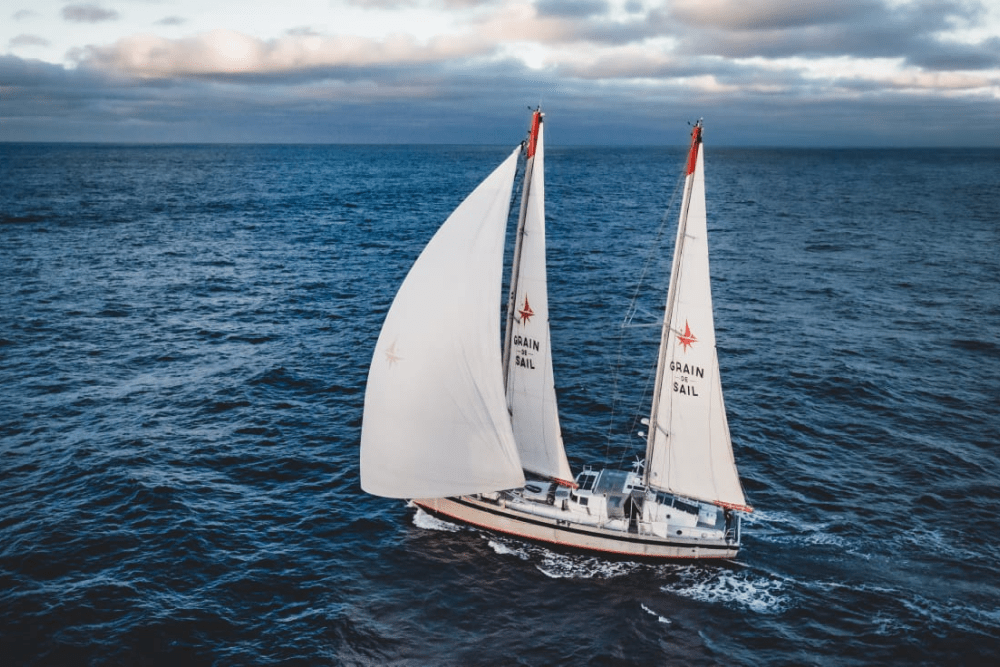Château Maris is a wine estate located in Féline Minervois. For more than 25 years, Robert Eden, winemaker & oenologist, has been working his land with respect for nature. He is considered as the pioneer of biodynamic agriculture in the Languedoc. To go further in his eco-responsible approach, Robert Eden called on Grain de Sail to make a wine delivery by sailboat.
Grain de Sail – Wine delivery by sailboat, and more.
Grain de Sail was created with the aim of reducing CO2 emissions. Initially, the project was about chocolate and coffee. They developed a whole range of products based on these two very popular ingredients. Grain de Sail is now diversifying its activities by shipping certain products on their boats. This is the case of the wine delivery by sailboat experimented by Château Maris!
Grain de Sail & Château Maris: a winning partnership.
Finally, the meeting of the two entities was obvious! On the one hand, a production that respects the living world and on the other hand a more ecological and faster method of transport. “Of course, it’s more expensive,” says Robert Eden, “but consumers are ready to participate to reduce CO2. A bottle of Naïve wine goes up from 19 to 24 dollars. Most often, they are pre-sold before they arrive.
Transport by cargo sailboat: what is the carbon impact?
Before looking at the carbon impact of a wine delivery by cargo ship compared to a conventional container ship, it is worth recalling how a cargo ship works.
A cargo sailboat: how does it work?
A cargo ship is first and foremost a sailboat: a boat with sails that uses the force of the wind to propel itself. Their first mission was to transport goods, passengers or mail over long distances. Nowadays, there are more than ten types of sailing ships that are used for recreational activities. The sailing cargo ship has been designed and optimised for the transport of large quantities of goods. Just like the classic sailing ship, its main energy source is the wind. But the Grain de Sail boat goes further by using all its environment: 2 hydro-generators, 2 windmills and 3 solar panel parks to produce electricity. It is also equipped with a 115 horsepower diesel propulsion engine.
What about carbon?
No theory to answer that question, just facts. In February 2021, the Grain de Sail boat transported dozens of tonnes of cocoa from New York to the finish in Saint-Malo. The result of the race: 40 litres of diesel consumed. Compared to a journey by conventional container ship, the carbon impact was divided by 10. As wine is heavier than chocolate, it is possible that the differential is even greater!
What is the future for wine delivery by sailing ship?
Wine delivery by sailboat represents a hope for the reduction of CO2 emissions in long-distance goods transport. The future for this activity seems bright. Especially if ships develop to hold more goods without losing their ecological advantage. The price of goods transported would be less and less affected by this method of delivery. This is what Stéfan Gallard, marketing director of Grain de Sail, says:
“For the moment, transport is more expensive because our boat is small. We can only take on board a maximum cargo of 50 tonnes. But in the future, with Grain de Sail 2, a 52-metre sailing boat that will be under construction in the next few weeks, we will be able to take on board 350 tonnes. So the cost price will be much lower.”
Discover the wines of Château Maris
For more information on Château Maris, click here.
To go further and discover the organic wines of the Maris brand, click here.
Discover Grain de Sail
For more information on the Grain de Sail cargo boats, visit their website.
Sources : Le Parisien | The Good Goods | Grain de Sail


Recent Comments